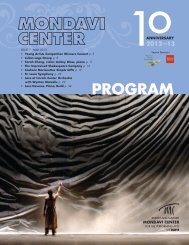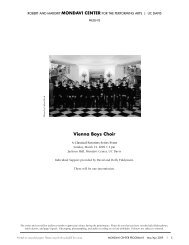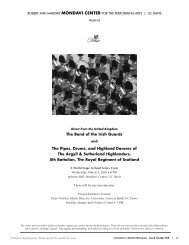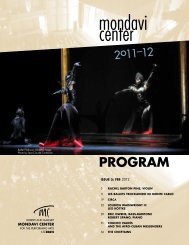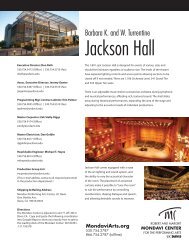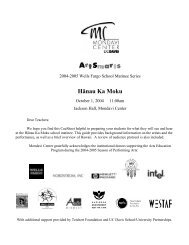NOVEMBER – DECEMBER 2013 - Mondavi Center
NOVEMBER – DECEMBER 2013 - Mondavi Center
NOVEMBER – DECEMBER 2013 - Mondavi Center
Create successful ePaper yourself
Turn your PDF publications into a flip-book with our unique Google optimized e-Paper software.
GIL SHAHAM<br />
wide-spanned chords that serve as<br />
harmonic pillars, establishing a stately<br />
underlying chordal pulse that supports<br />
the movement’s vinelike and expansive<br />
melodic lines.<br />
The second movement is a fugal<br />
Allegro, right out of the Corellian<br />
playbook. However, Bach was never<br />
one to follow tradition slavishly, and<br />
here he enlivens the standard template<br />
of subjects-separated-by-episodes by<br />
interleaving his fugal elements with<br />
glittering single-line passagework<br />
that could have stepped right out of a<br />
virtuoso concerto. Bach’s astounding<br />
ingenuity at implying a full complement<br />
...near-nonstop sixteenth<br />
notes erupt from the<br />
strings like so many<br />
wheels whirring and<br />
gears clicking...<br />
of polyphonic voices with just a few<br />
strings was noted by admirers from<br />
early on. Even after Bach’s own<br />
polyphonically-enhanced transcriptions<br />
for organ (BWV 539) and lute (BWV<br />
1000), not to mention the passing of<br />
almost three centuries, the solo violin<br />
original has lost none of its capacity to<br />
inspire and astonish.<br />
The third-place Siciliano returns<br />
us to song, a Bachian aria that brings<br />
both soloist and accompaniment to<br />
vivid life via the four strings of a solo<br />
violin. Gentle and faintly melancholic,<br />
the major-mode movement provides<br />
the perfect foil for the conclusion, a<br />
minor-key Presto that reminds us of the<br />
18th century’s fascination with all things<br />
scientific and mechanical. Resembling<br />
a finger-bending keyboard fantasia,<br />
near-nonstop sixteenth notes erupt from<br />
the strings like so many wheels whirring<br />
and gears clicking, in a virtuoso moto<br />
perpetuo finale that brings the sonata<br />
to an appropriately dazzling close.<br />
—Scott Foglesong<br />
PARTITA NO. 1 FOR SOLO VIOLIN<br />
IN B MINOR, BWV 1002<br />
Suites (partitas in Italian) make up<br />
a substantial percentage of Bach’s<br />
instrumental works. Consider the 18<br />
keyboard suites, divided into six each<br />
English Suites, French Suites, and Partitas,<br />
plus the substantial “French Ouverture”<br />
Partita and a few oddball remainders.<br />
Bach also wrote suites for solo flute,<br />
orchestra, lute, and solo cello in addition<br />
to the three partitas for solo violin.<br />
Given the dance suite’s international<br />
provenance, Bach routinely mixed Italian<br />
and French dance dialects, despite<br />
their often striking differences—such<br />
as the zippy Italian corrente versus the<br />
stately, rhythmically complex French<br />
courante. Although Bach routinely<br />
organized his keyboard suites around<br />
four standardized dances—Allemande,<br />
Courante, Sarabande, Gigue—he took a<br />
more idiosyncratic approach in the three<br />
violin partitas, no doubt recognizing the<br />
unique requirements of writing for a solo<br />
string instrument.<br />
In the B Minor Partita for Solo Violin,<br />
Bach provides four dance movements,<br />
each followed by an étude-like variation<br />
called a “double.” (This is the only<br />
suite in which Bach sustained such a<br />
scheme throughout.) Listeners lacking<br />
a program might be confused by the<br />
opening Allemanda, thinking that they<br />
are hearing the stately dotted-rhythm<br />
opening of an ouverture à la française.<br />
Certainly the Allemanda represents<br />
the French style at its most grand and<br />
ceremonious, but the following Double<br />
abandons the Gallic character in favor of<br />
smoothly arpeggiated (i.e., chordal) lines<br />
that rise and fall with almost hypnotic<br />
regularity as they outline the movement’s<br />
underlying harmonies.<br />
The rest of the suite is resolutely<br />
Italianate. The bubbly, perpetualmotion<br />
second dance is actually a<br />
Corrente, but in keeping with Bach’s<br />
overall label-agnostic cosmopolitanism,<br />
many editions (including the Bach<br />
Gesellschaft) dub it as a Courante. On<br />
the page the movement might look as<br />
though it consists of a single melodic<br />
line, but to the ear the situation is<br />
markedly different: at least three voices<br />
are easily audible, especially a high<br />
soprano that etches out brisk two-note<br />
figures answered by arpeggios in a<br />
middle voice and supported by a solid<br />
bass line down below. The Corrente’s<br />
virtuosic stance is proudly unabashed,<br />
but that’s nothing compared to its<br />
Double, which halves the note values and<br />
turns a dance into a scamper.<br />
The Sarabande follows the traditional<br />
Italian vein with fetching lyricism<br />
over steady, regular chord changes.<br />
Movements such as this, featuring<br />
numerous instances of four-note<br />
chords, led to sincere but misguided<br />
efforts in the 20th century to design a<br />
special violin bow that could be quickly<br />
loosened to play four strings at once.<br />
Such gimmicks are not only unhistoric<br />
but unnecessary; sensitive technique<br />
and careful attention to sonority<br />
will ensure success in playing Bach’s<br />
expansive chords. The Double transforms<br />
the Sarabande’s block harmonies into<br />
lilting and graceful arpeggios.<br />
Bach chose an alternative to the<br />
Gigue for his finale, a Tempo di Borea,<br />
a.k.a. bourrée, a dance normally found<br />
between the Sarabande and Gigue of<br />
a traditional suite. Jumpy, athletic and<br />
vivacious, both the Tempo di Borea and<br />
its perpetual-motion Double provide<br />
a fine and festive wrap-up to the<br />
proceedings. —Scott Foglesong<br />
SUITE NO. 2 FOR SOLO VIOLIN<br />
WILLIAM BOLCOM<br />
(Born May 26, 1938, in Seattle, Wash.)<br />
I’d wished to learn the violin when<br />
young, but for several reasons (including<br />
the theft of my grandfather’s Sears<br />
“Stradivarius” from the family car), I never<br />
got to learn to play; I still wish I had. I<br />
had to settle for learning how to write<br />
for the violin by working with violinists<br />
from a young age—in fact a principal<br />
joy for me as a composer has been to<br />
write for others what I might have been<br />
delighted to be able to perform myself—<br />
but the added dividend is that writing<br />
for someone else can then become a<br />
portrait of the performer. That makes<br />
it actually more gratifying for me than<br />
writing for myself to play, a thing I rarely<br />
do nowadays.<br />
My first solo violin suite was written<br />
at the request of Sergiu Luca, who<br />
10 MONDAVIARTS.ORG



